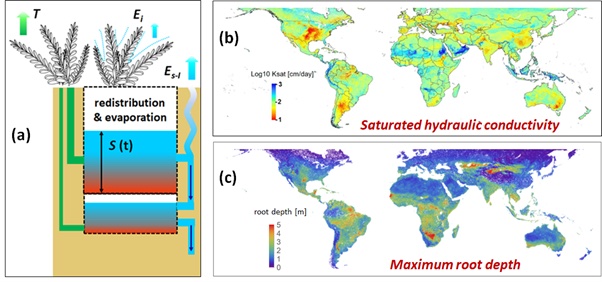Modeling Evapotranspiration at Global Scale
Evapotranspiration (ET) modeling is central to resolve water and energy balances and linking the terrestrial water and carbon cycles. An important challenge remains how to partition the ET flux into transpiration (T) and soil evaporation (E). Estimates from literature and predictions based on land surface models range between 10-90 % depending on model assumptions. ET and its partitioning depend on the soil hydraulic properties shaping the redistribution of precipitation and the adaption of plants to transport water from the roots to the stomata. To improve predictions of ET at global scale, we invest on three elements as shown in Figure 1: (a) modeling ET as function of critical water content in the surface layer and the root zone, (b) applying the most recent global maps of soil hydraulic properties, and (c) improving maps of root length distribution.

ET for each pixel of the global map is simulated by a two-layered ‘soil capacitor’ consisting of a surface layer and the root zone. For that purpose, we expand the surface evaporation capacitor model of Or and Lehmann (2019) by considering concurrent root water uptake. The original capacitor model simulates surface evaporation (focusing on stage-1) and internal redistribution following rainfall events. The thickness of the evaporation-active soil layer is defined by an intrinsic soil property termed the evaporation characteristic length (deduced from soil water characteristics and hydraulic conductivity functions). The modified model considers water extraction by plant roots (Carminati and Javaux 2020) from the capacitor layer as well as water redistributed into deeper layers (sheltered from soil evaporation but accessible for root water uptake). Depending on the amount of water leaking below the capacitor depth, vegetation can take up this natural storage at rates limited by the hydraulic properties of the rhizosphere.
Contact: Peter Lehmann (), Andrea Carminati (), Fabian Wankmüller ()